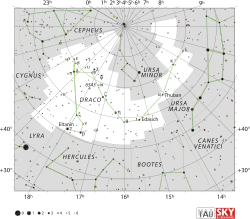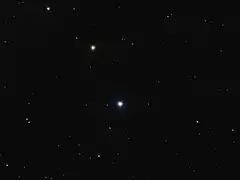Kappa Draconis
Kappa Draconis, Latinized from κ Draconis, is a blue giant star located in the northern circumpolar constellation of Draco. At an apparent magnitude of 3.88, it is barely visible to the naked eye when artificial lighting from cities is present. Nevertheless, it is a powerful star, approximately five time as massive as the Sun. It is about 460 light-years away, and is 1,400 times brighter than the Sun.
 | |
| Observation data Epoch J2000 Equinox J2000 | |
|---|---|
| Constellation | Draco |
| Right ascension | 12h 33m 28.94206s[1] |
| Declination | +69° 47′ 17.6331″[1] |
| Apparent magnitude (V) | 3.82[2] |
| Characteristics | |
| Spectral type | B6 IIIe[3] |
| U−B color index | –0.61[2] |
| B−V color index | –0.11[2] |
| Astrometry | |
| Radial velocity (Rv) | –11.4[4] km/s |
| Proper motion (μ) | RA: –58.162[1] mas/yr Dec.: +11.802[1] mas/yr |
| Parallax (π) | 7.1387 ± 0.3291 mas[1] |
| Distance | 460 ± 20 ly (140 ± 6 pc) |
| Absolute magnitude (MV) | −2.03[5] |
| Orbit[6] | |
| Period (P) | 61.555 d |
| Eccentricity (e) | 0 |
| Periastron epoch (T) | JD 2449980.22 |
| Semi-amplitude (K1) (primary) | 6.81 km/s |
| Details | |
| Mass | 4.8[7] M☉ |
| Radius | 6.4[7] R☉ |
| Luminosity | 1,115[5] L☉ |
| Surface gravity (log g) | 3.5[7] cgs |
| Temperature | 14,000[7] K |
| Metallicity [Fe/H] | −0.65[5] dex |
| Rotational velocity (v sin i) | 170[7] km/s |
| Other designations | |
| Database references | |
| SIMBAD | data |

The star is currently located at declination 69° 47' 18" North (RA 12h 33m 29.0s), but due to the effects of precession, Kappa Draconis was the nearest star to the North Celestial Pole visible to the naked eye from 1793 BC to approximately 1000 BC, though it was 6° removed from perfect alignment, making it only an approximate pole star, similar to the roughly 7° variance from perfect alignment of the much brighter (magnitude 2.08) star Kochab, at the same time during Earth's precession.
Properties
Kappa Draconis is a classical Be star, displaying Balmer emission lines in its spectrum.[9] It is spinning rapidly with a projected rotational velocity of 170 km/s.[7] The star is thought to be just entering its red giant phase, having exhausted the supply of hydrogen in its core. Over the next several thousand years, the star will expand, becoming more powerful but with a much cooler surface temperature. Tens of thousands of years from now, Kappa Draconis will appear much brighter, probably shining with a reddish hue.
Kappa Draconis is a single-lined spectroscopic binary.[10] The main Be star is orbited by another stellar companion, on a circular orbit with a period of 61.555 days.[6]
Chinese name
In Chinese, 紫微右垣 (Zǐ Wēi Yòu Yuán), meaning Right Wall of Purple Forbidden Enclosure, refers to an asterism consisting of κ Draconis, α Draconis, λ Draconis, 24 Ursae Majoris, 43 Camelopardalis, α Camelopardalis and BK Camelopardalis.[11] Consequently, the Chinese name for κ Draconis itself is 紫微右垣二 (Zǐ Wēi Yòu Yuán èr, English: the Second Star of Right Wall of Purple Forbidden Enclosure.),[12] representing 少尉 (Shǎowèi), meaning Second Chief Judge[13]
References
- Brown, A. G. A.; et al. (Gaia collaboration) (August 2018). "Gaia Data Release 2: Summary of the contents and survey properties". Astronomy & Astrophysics. 616. A1. arXiv:1804.09365. Bibcode:2018A&A...616A...1G. doi:10.1051/0004-6361/201833051. Gaia DR2 record for this source at VizieR.
- Crawford, D. L.; Barnes, J. V.; Golson, J. C. (1971), "Four-color, H-beta, and UBV photometry for bright B-type stars in the northern hemisphere", The Astronomical Journal, 76: 1058, Bibcode:1971AJ.....76.1058C, doi:10.1086/111220
- Balona, L. A.; Dziembowski, W. A. (October 1999), "Excitation and visibility of high-degree modes in stars", Monthly Notices of the Royal Astronomical Society, 309 (1): 221–232, Bibcode:1999MNRAS.309..221B, doi:10.1046/j.1365-8711.1999.02821.x
- Wilson, R. E. (1953). General Catalogue of Stellar Radial Velocities. Carnegie Institute of Washington D.C. Bibcode:1953GCRV..C......0W.
- Anderson, E.; Francis, Ch. (2012), "XHIP: An extended hipparcos compilation", Astronomy Letters, 38 (5): 331, arXiv:1108.4971, Bibcode:2012AstL...38..331A, doi:10.1134/S1063773712050015, S2CID 119257644.
- Saad, S. M.; Kubát, J.; Hadrava, P.; Harmanec, P.; Koubský, P.; Škoda, P.; Šlechta, M.; Korčáková, D.; Yang, S. (2005). "Spectrum Disentangling and Orbital Solution for κ Dra". Astrophysics and Space Science. 296 (1–4): 173–177. Bibcode:2005Ap&SS.296..173S. doi:10.1007/s10509-005-4438-7. S2CID 189844885.
- Saad, S. M.; Kubát, J.; Koubský, P.; Harmanec, P.; Škoda, P.; Korčáková, D.; Krtička, J.; Šlechta, M.; Božić, H.; Ak, H.; Hadrava, P.; Votruba, V. (2004). "Properties and nature of Be stars. XXIII. Long-term variations and physical properties of κ Dra". Astronomy & Astrophysics. 419 (2): 607–621. doi:10.1051/0004-6361:20034241. S2CID 119007669.
- "kap Dra". SIMBAD. Centre de données astronomiques de Strasbourg. Retrieved 2012-02-06.
- Banerjee, Gourav; et al. (January 2021), "Optical spectroscopy of Galactic field classical Be stars", Monthly Notices of the Royal Astronomical Society, 500 (3): 3926–3943, arXiv:2011.08622, Bibcode:2021MNRAS.500.3926B, doi:10.1093/mnras/staa3469.
- Hutter, D. J.; Tycner, C.; Zavala, R. T.; Benson, J. A.; Hummel, C. A.; Zirm, H. (2021). "Surveying the Bright Stars by Optical Interferometry. III. A Magnitude-limited Multiplicity Survey of Classical Be Stars". The Astrophysical Journal Supplement Series. 257 (2): 69. arXiv:2109.06839. Bibcode:2021ApJS..257...69H. doi:10.3847/1538-4365/ac23cb. S2CID 237503492.
- (in Chinese) 中國星座神話, written by 陳久金. Published by 台灣書房出版有限公司, 2005, ISBN 978-986-7332-25-7.
- (in Chinese) AEEA (Activities of Exhibition and Education in Astronomy) 天文教育資訊網 2006 年 6 月 11 日
- English-Chinese Glossary of Chinese Star Regions, Asterisms and Star Name Archived 2008-09-24 at the Wayback Machine, Hong Kong Space Museum. Accessed on line November 23, 2010.